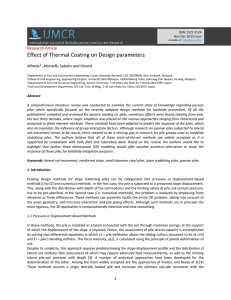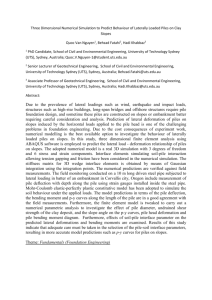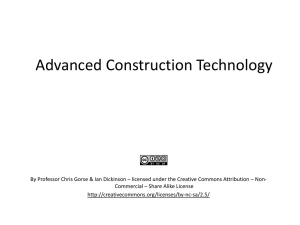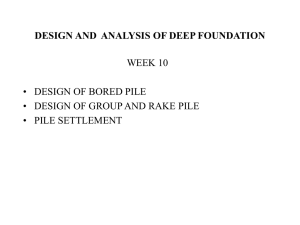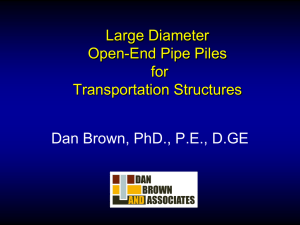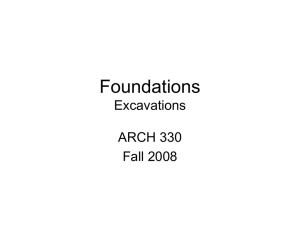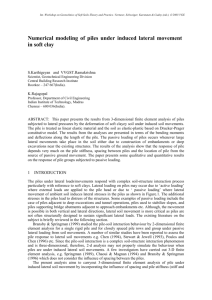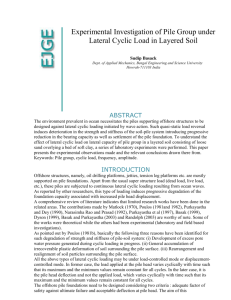Template-IJMCR1
advertisement
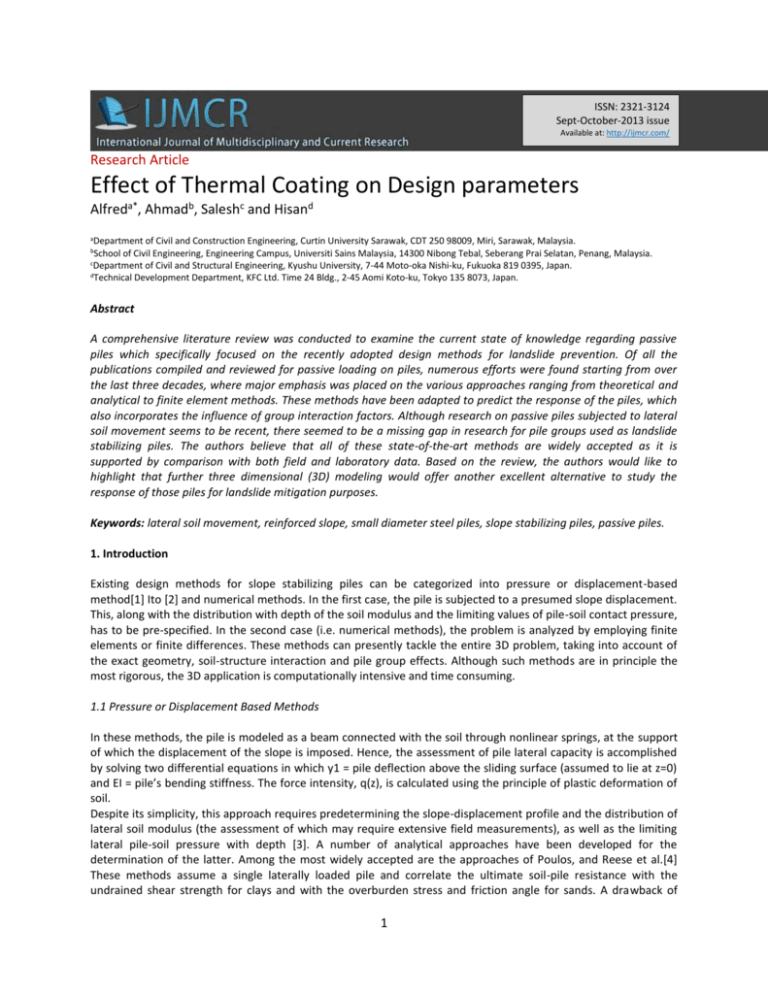
ISSN: 2321-3124
Sept-October-2013 issue
Available at: http://ijmcr.com/
Research Article
Effect of Thermal Coating on Design parameters
Alfreda*, Ahmadb, Saleshc and Hisand
aDepartment
of Civil and Construction Engineering, Curtin University Sarawak, CDT 250 98009, Miri, Sarawak, Malaysia.
of Civil Engineering, Engineering Campus, Universiti Sains Malaysia, 14300 Nibong Tebal, Seberang Prai Selatan, Penang, Malaysia.
cDepartment of Civil and Structural Engineering, Kyushu University, 7-44 Moto-oka Nishi-ku, Fukuoka 819 0395, Japan.
dTechnical Development Department, KFC Ltd. Time 24 Bldg., 2-45 Aomi Koto-ku, Tokyo 135 8073, Japan.
bSchool
Abstract
A comprehensive literature review was conducted to examine the current state of knowledge regarding passive
piles which specifically focused on the recently adopted design methods for landslide prevention. Of all the
publications compiled and reviewed for passive loading on piles, numerous efforts were found starting from over
the last three decades, where major emphasis was placed on the various approaches ranging from theoretical and
analytical to finite element methods. These methods have been adapted to predict the response of the piles, which
also incorporates the influence of group interaction factors. Although research on passive piles subjected to lateral
soil movement seems to be recent, there seemed to be a missing gap in research for pile groups used as landslide
stabilizing piles. The authors believe that all of these state-of-the-art methods are widely accepted as it is
supported by comparison with both field and laboratory data. Based on the review, the authors would like to
highlight that further three dimensional (3D) modeling would offer another excellent alternative to study the
response of those piles for landslide mitigation purposes.
Keywords: lateral soil movement, reinforced slope, small diameter steel piles, slope stabilizing piles, passive piles.
1. Introduction
Existing design methods for slope stabilizing piles can be categorized into pressure or displacement-based
method[1] Ito [2] and numerical methods. In the first case, the pile is subjected to a presumed slope displacement.
This, along with the distribution with depth of the soil modulus and the limiting values of pile-soil contact pressure,
has to be pre-specified. In the second case (i.e. numerical methods), the problem is analyzed by employing finite
elements or finite differences. These methods can presently tackle the entire 3D problem, taking into account of
the exact geometry, soil-structure interaction and pile group effects. Although such methods are in principle the
most rigorous, the 3D application is computationally intensive and time consuming.
1.1 Pressure or Displacement Based Methods
In these methods, the pile is modeled as a beam connected with the soil through nonlinear springs, at the support
of which the displacement of the slope is imposed. Hence, the assessment of pile lateral capacity is accomplished
by solving two differential equations in which y1 = pile deflection above the sliding surface (assumed to lie at z=0)
and EI = pile’s bending stiffness. The force intensity, q(z), is calculated using the principle of plastic deformation of
soil.
Despite its simplicity, this approach requires predetermining the slope-displacement profile and the distribution of
lateral soil modulus (the assessment of which may require extensive field measurements), as well as the limiting
lateral pile-soil pressure with depth [3]. A number of analytical approaches have been developed for the
determination of the latter. Among the most widely accepted are the approaches of Poulos, and Reese et al.[4]
These methods assume a single laterally loaded pile and correlate the ultimate soil-pile resistance with the
undrained shear strength for clays and with the overburden stress and friction angle for sands. A drawback of
1
Alfred et al
International Journal of Multidisciplinary and Current Research, September-October-2013 issue
these methods is that group effects are simplistically taken into account by the application of reduction factors. Ito
and Matsui [5]developed a plastic extrusion-deformation model for rigid piles of infinite length (and not closely
spaced) to estimate the shear resistance offered by a row of piles embedded in a slope. Their approach presumes
that the soil is soft and deforms plastically around piles. Despite its rigor, the method neglects pile flexibility, pile
limited length, and soil arching-phenomena that may all have a substantial effect . This approach has formed the
basis of a number of design methods.
1.2 Numerical Method
Because of the dramatic progress in computing and software power over the last few years, the finite element (FE)
and finite difference (FD) methods are increasingly popular. These methods provide the ability to model complex
geometries and soil-structure interaction phenomena such as pile-group effects. Moreover, they are able to model
the three dimensionality of the problem, and may well capture soil and pile non-linearity. As early as 1979, Rowe
and Poulos [2] developed a two dimensional (2D) finite element approach that, in a simplified way, accounted for
the three dimensional (3D) effect of soil flowing through rows of piles.
2. Recent Development on Slope Stabilizing Piles
Hereafter, some of the current research pertaining to slope stabilizing piles undertaken by some researchers are
discussed, taking into consideration the aspects of the newly adopted techniques available in the field at present
namely the hybrid method of analysis, uncoupled method of analysis and also the coupled method of analysis.
2.1 Hybrid Method of Analysis
This method was proposed by Kourkoulis [2] which develop a hybrid method for designing slope-stabilizing piles,
combining the accuracy of rigorous three dimensional (3D) finite elements (FE) simulation with the simplicity of
widely accepted analytical techniques. It consists of two steps: (1) evaluation of the lateral resisting force (RF)
needed to increase the safety factor of the precarious slope to the desired value, and (2) estimation of the
optimum pile configuration that offers the required RF for a prescribed deformation level. The first step utilizes the
results of conventional slope-stability analysis. A novel approach is proposed for the second step. This consists of
decoupling the slope geometry from the computation of pile lateral capacity, which allows numerical simulation of
only a limited region of soil around the piles. A comprehensive validation is presented against published
experimental, field, and theoretical results from fully coupled 3D nonlinear FE analyses. The proposed method
provides a useful, computationally efficient tool for parametric analyses and design of slope stabilizing piles.
2.2 Uncoupled Method of Analysis
The uncoupled method of analysis for slope stabilizing piles stems for the fact that the pile response (i.e. pile
displacement, bending moment, shear force and also pile deflection) and slope stability are considered separately
according to their specified method of analysis. A study conducted by Jeong et al., [5] describes a simplified
numerical approach for analyzing the slope-pile system subjected to lateral soil movements. The lateral one-row
pile response above and below the critical surface is computed by using load transfer approach. The response of
groups was analyzed by developing interaction factors obtained from a three-dimensional nonlinear finite element
study. The nonlinear characteristics of the soil-pile interaction in the stabilizing piles are modeled by hyperbolic
load transfer curves. The Bishop’s simplified method of slope stability analysis is extended to incorporate the soilpile interaction and evaluate the safety factor of the reinforced slope. Numerical study is performed to illustrate
the major influencing parameters on the pile-slope stability problem. Through comparative studies, it has been
found that the factor of safety in slope is much more conservative for an uncoupled analysis than for a coupled
analysis based on three-dimensional finite element analysis.
2
Alfred et al
International Journal of Multidisciplinary and Current Research, September-October-2013 issue
Figure 1: A pile undergoing lateral soil movement
Table 1: Weight from inputs to hidden layer
Weight from inputs to hidden layer
bias {1}
-12.8441
20.50278
-15.5231
-3.11923
4.49661
21.47516
-18.7561
7.291488
-0.70412
0.353977
-0.47013
24.87071
0.687205
0.890272
5.426286
-8.8521
-2.76763
-2.32015
-0.59351
-0.61689
3.240572
13.79844
2.490056
-0.66864
-6.69662
4.196722
41.84173
14.72279
0.29078
0.478036
22.86743
-6.45144
-11.0188
3.009632
-3.71165
-20.87
-0.39003
-0.60865
3.487829
1.250031
3.010849
3.881527
0.155606
0.177922
-0.26915
-0.4196
-0.91266
-1.09495
-25.5709
-0.7389
4.654554
-1.52011
-17.6461
-17.9528
-5.65354
-1.76028
-7.76329
-5.84226
-3.01687
3.352388
-4.23849
-0.55612
0.234111
-2.33927
6.767685
-4.96711
0.119874
6.354606
-16.5281
-19.8093
-23.6356
-10.8796
-3.31287
22.76426
8.615496
-0.72317
1.425839
-39.4266
-1.34297
-0.86946
4.300653
18.72181
4.853103
-1.39389
4.857575
-7.19375
-4.68344
0.950667
11.97972
-1.46213
3. Results and Analysis
This section will address the analysis’s outcomes of the Objects consisted of 50 respondents. A survey tool was
created to determine the important usages of public spaces in Jalan Wang Ah Fook, the physical qualities of public
spaces in the study area and the reasons and the factors influencing it. To discover the symbolic value of study
area, the quantifiable researches and the qualitative interviews were adopted. At the first, Data were collected by
filling-out the survey forms. As mentioned survey questions are divided into three parts. The Socio-demographic
background is composed of variables that may affect the common space, such as gender, age. Respondents differ
in functional, cultural and social characteristics. Among 50 respondents, between male and female using the public
3
Alfred et al
International Journal of Multidisciplinary and Current Research, September-October-2013 issue
space, female registered as the majority (56%) of users of public space in Jalan Wong Ah Fook and the distribution
of participants according to their age. The majority of the participants’ age was 19 to 25 with percentage 42%.
3.1 The respondents’ familiarity with public places located at Jalan Wong Ah Fook
People go to the places that are familiar with or at least know where they are. On the other hand, those places
which are memorized by users concern as places with significant identifications to make users use them. Due
estimating the most distinctive public places and spaces and the amount of people’s familiarity with mentioned
public places, respondents were asked to specify that do they know those mentioned places in Jalan Wong Ah
Fook. As shown in figure 2, City Square is the most well known public place for users. On the other hand, sidewalk
between buildings and street curb is the less notable place for users. Regarding the information from this part of
analysis, City Sauer (98%), Hindu Temple (68%), Public Bank Building (66%), Chinese Temple (62%), The Sungai
Segget River (56%), Masjid India (50%), Shop houses areas (42%), Sultan Ibrahim Building (38%) and sidewalk
between buildings and street curb (32%) are registered from the most well-known places to least. As next step of
analysis, this study is going to evoke which places have most usage for respondents as public places and spaces.
Acknowledgement
The authors appreciate t Mr. Ahmet for his kind support in conducting the experimental work
References
[1] N. Menon and P. W. Wong (2001), A buyer-seller watermarking protocol, IEEE Trans. Signal Process.,
vol.10,no.4,pp.643-649.
[2] M.Johnson, P. Ishawar, V.M. Prabhakaran, D. Schonberg, and K. Ramachandran (2004), On compressing
encrypted data, IEEE Trans. Signal Process., vol. 52, no. 10, pp.2992-3006.
[3] M. Kuribayashi and H. Tanaka (2005), Fingerprinting protocol for images based on additive homomorphic
property, IEEE Trans Image Process., vol. 14, no.12,pp. 2129-2139.
[4] Z. Ni, Y. Q. Shi, N. Ansari, and W. Su (2006), Reversible data hiding, IEEE Trans. Circuits Syst. Video Technol.,vol.
16,no. 3,pp. 354-362.
[5] S. Lian, Z. Liu, Z.Ren, and H. Wang (2007), Commutative encryption and watermarking in video compression,
IEEE Trans. Circuit Syst. Video Technol., vol. 17,no. 6, pp. 774-778.
4

